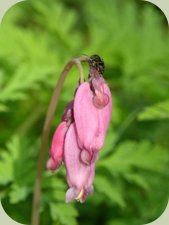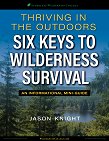Pacific Bleeding Heart Plants

Pacific bleeding heart plants (Dicentra formosa) are found throughout the moist lowland coniferous forests of the Pacific Northwest. It is a delicate, low-growing beauty, also known as the western bleeding heart. Its delightful flowers give it its name.
This graceful plant has small, perfectly heart-shaped flowers growing in small clusters on top of a long, thin stalk. The lacy, much-divided and fern-like leaves grow directly out of the ground on similarly long and thin stalks. The leaves often make a fine blanket of growth over the forest floor. Bleeding hearts grow from a fragile rhizome which grows very near to the surface of the soil. Once pollinated, the flowers erupt with long, pea-like seed pods.
This plant has a symbiotic relationship with ants on the forest floor. The seeds it produces are black and shiny with little white appendages on them. These oily, white parts on the seeds attract ants. The ants pick them up; carry them back to their hills or burrows where they consume the white part of the attached to the seed, and dispose of the rest on their refuse piles. Those seeds then germinate where they fall. This is how they are are dispersed through the forest.
Pacific bleeding hearts range from southern British Columbia, down into the Sierra Nevada mountains of California, as well as a few similar locations in Idaho and northwestern Montana. It prefers forest habitats such as thickets, stream banks, ravines and other moist locations.
Be More Prepared For Your Next Outdoor Adventure!

Don't leave home without knowing these six essential survival skills. Our free survival mini guide reveals the strategies of:
- Shelter & fire to prevent the number one cause of death
- Obtaining clean water to avoid life-threatening dehydration
- Common wild survival foods and other critical skills!

Medicinal Uses for the Bleeding Heart Plant
As with so many plants in the Pacific Northwest, this species also has medicinal value. In the form of a root tincture or hot compress it can help pain relief, and can be applied externally to bruises and sprains. Internally, the tincture of bleeding heart can also help calm frazzled nerves especially after a frightening experience such as an accident or other trauma. The roots of this plant are generally gathered in summer and fall, up to the time when the leaves start to turn. While the foliage is best collected after the seedpods are matured and can be sown to help the plant.
This plant is especially delicate, and easily impacted by foot traffic so the observing or collecting of this plant should be done with great care and consideration. Once trodden on, it is not likely to spring back to its original upright form, and the leaves and flowers often soon die. Though this plant is common in its preferred habitats, it should be approached with a caretaker's attitude.
So, next time you are walking through a moist, coniferous forest keep your eyes low and see if you can spot this little gem, the Pacific bleeding heart plants.
By the way, when you're out foraging, it's important to know how to stay safe in the outdoors, especially if you were to get lost. Right now you can get a free copy of our mini survival guide here, where you'll discover six key strategies for outdoor emergencies, plus often-overlooked survival tips.
References: Pojar 1994, Moore 1993
Additional Resources:
Check out this great technical information from Evergreen State College.
To learn about more medicinal plants check our Plants Courses.

About the Author: Filip Tkaczyk is a periodic guest teacher at Alderleaf. He also wrote the field guide Tracks & Sign of Reptiles & Amphibians. Learn more about Filip Tkaczyk.
Return from Bleeding Heart Plants back to Wild Plants Articles
Is The Essential Wilderness Survival Skills Course Right for You? Take the "Online Survival Training Readiness" Quiz
See for yourself if this eye-opening course is a good fit for you. It takes just a few minutes! Get your Survival Training Readiness Score Now!

Grow Your Outdoor Skills! Get monthly updates on new wilderness skills, upcoming courses, and special opportunities. Join the free Alderleaf eNews and as a welcome gift you'll get a copy of our Mini Survival Guide.

 The Six Keys to Survival: Get a free copy of our survival mini-guide and monthly tips!
The Six Keys to Survival: Get a free copy of our survival mini-guide and monthly tips!
Learn more